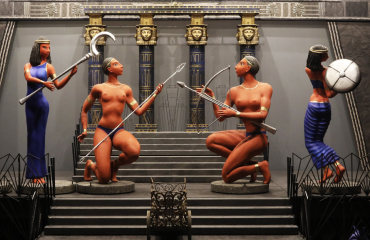Erarta Museum presented an exhibition by Anastasia Slavnova whose soul-searching landscapes help one escape the outside world and plunge deep into the subconscious
- Artworks inspired by Hermann Hesse’s The Glass Bead Game
- Multilayered painting texture created with unusual materials and instruments
- Exploration of the primeval core of the human nature
With the rapid spread of photography in the early 20th century, painters no longer strived to imitate reality and started to explore more profound emotional and subconscious states. Expressionism became the dominant art movement of the time. Artworks by its contemporary successor Anselm Kiefer clearly demonstrate that the existential experience is more accurately expressed through complex textures than by garish colours. Alongside paints, Kiefer incorporates into his canvases various materials instrumental to human evolution, including clay, sand, wood, straw, ash, and metal. Like an alchemist, he turns textures into meanings.
Anastasia Slavnova also works with intricate textures and often resorts to unconventional painting tools – for instance, a rolling pin or a pet hair remover. Soil, moss, and twigs are layered on the canvas together with paint. The resulting images of desolate spaces are interpreted by the artist as ‘soul-searching landscapes wherein visions of nature help one escape the outside world, plunge into the depths of subconscious, and reunite with one’s primeval core.’
Anastasia’s most recent works were inspired by Hermann Hesse’s novel The Glass Bead Game. The book tells about Castalia, a utopian haven for intellectuals weaving a metatext consisting of quotes and associations related to all existing artworks. One of the paintings featured in the exhibition that became the artist’s departure point is titled Transcend. The same title was initially given by Hesse’s main protagonist to his poem quoted as the epigraph to this text.
Anastasia Slavnova regards her canvases as milestones on her personal journey, describing her latest series in the following way: ‘The artist perceives life as a game in which the end of one stage is the beginning of another. This circle of inner deaths and rebirths, time spent looking for answers and finding a path forward is the recurring motif of all works. Each stage in life has an undertone of decline and death, which subsequently lead to a new horizon and new beginning.’ The difficulty of grasping the world with all its injustices and contradictions is reflected in the labyrinthine buildings and multi-layered texture of paintings. We see abandoned structures of an erstwhile mysteriously beautiful utopia whose harmony is ruined by the entropy of chaos.
Erasing the Boundaries is one of the exhibitions initiated through the feedback form on the museum’s website. Erarta offers both beginning and professional artists of various genres an opportunity to reach out to their viewers, introducing its visitors to highly original artworks.













